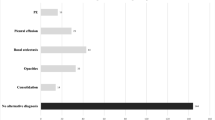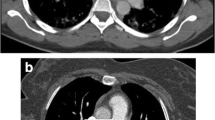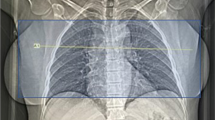Abstract
The aim of this study is to determine the feasibility of using reduced scan range CT pulmonary angiography technique in pregnancy for pulmonary embolism (PE) and to quantify resulting dose reduction. This was a retrospective study. Eighty-four CTPA exams performed on pregnant women during 2004–2012. The scans were modified to create reduced anatomic coverage scans extending from aortic arch to base of heart. These were separately evaluated by two radiologists for PE and non-PE abnormalities. The results were then compared by the third radiologist with original radiology report and scans. Radiation dose reduction was evaluated prospectively in 36 patients as part of a quality control project. Two patients had PE and were successfully identified on reduced z-axis scans. Thirty-two exams were normal; rest had 60 pertinent and 16 had incidental findings. There were four incidental findings which included three benign thyroid nodules and one benign small lung nodule which were missed. None of these affected clinical outcome or management. There was 71 % radiation dose reduction. No PE or any important diagnoses are missed using reduced z-axis CTPA in pregnancy. There is a substantial radiation dose reduction. Hence, this technique is highly recommended in pregnancy.

Similar content being viewed by others
References
Chang J, Elam-Evans L, Berg C et al (2003) Pregnancy-related mortality surveillance--united states, 1991–1999. MMWR Surveill Summ 52:1–8
Leung AN, Bull TM, Jaeschke R et al (2011) An official american thoracic society/society of thoracic radiology clinical practice guideline: evaluation of suspected pulmonary embolism in pregnancy. Am J Respir Crit Care Med 184:1200–1208
Shahir K, Goodman LR, Tali A, Thorsen KM, Hellman RS (2010) Pulmonary embolism in pregnancy: Ct pulmonary angiography vs perfusion scan – eight-year experience. AJR Am J Roentgenol 195:W214–220
Schuster ME, Fishman JE, Copeland JF, Hatabu H, Boiselle PM (2003) Pulmonary embolism in pregnant patients: a survey of practices and policies for ct pulmonary angiography. AJR Am J Roentgenol 181:1495–1498
Pahade JK, Litmanovich D, Pedrosa I, Romero J, Bankier AA, Boiselle PM (2009) Quality initiatives: imaging pregnant patients with suspected pulmonary embolism: what the radiologist needs to know. Radiographics 29:639–654
Winer-Muram HT, Boone JM, Brown HL, Jennings SG, Mabie WC, Lombardo GT (2002) Pulmonary embolism in pregnant patients: fetal radiation dose with helical ct. Radiology 224:487–492
Webb JA, Thomsen HS, Morcos SK (2005) The use of iodinated and gadolinium contrast media during pregnancy and lactation. Eur Radiol 15:1234–1240
Kalra MK, Maher MM, Sahani DV et al (2003) Low-dose ct of the abdomen: evaluation of image improvement with use of noise reduction filters—pilot study1. Radiology 228:251–256
Heyer CM, Mohr PS, Lemburg SP, Peters SA, Nicolas V (2007) Image quality and radiation exposure at pulmonary ct angiography with 100- or 120-kvp protocol: prospective randomized study. Radiology 245:577–583
Kalra MK, Maher MM, Toth TL et al (2004) Strategies for ct radiation dose optimization1. Radiology 230:619–628
Shahir K, Goodman LR, Lam CA, Midia EC (2013) Dose reduction of 69 % for computed tomography pulmonary angiography: reduced z-axis computed tomography pulmonary angiography retains accuracy in those younger than 40 years. J Comput Assist Tomogr 37:765–769
Kallen J, Coughlin B, O’Loughlin M, Stein B (2010) Reduced z-axis coverage multidetector ct angiography for suspected acute pulmonary embolism could decrease dose and maintain diagnostic accuracy. Emerg Radiol 17:31–35
Atalay MK, Walle NL, Egglin TK (2011) Prevalence and nature of excluded findings at reduced scan length ct angiography for pulmonary embolism. J Cardiovasc Comput Tomogr 5:325–332
Huda W, Ogden KM, Khorasani MR (2008) Converting dose-length product to effective dose at ct1. Radiology 248:995–1003
Kuiper JW, Geleijns J, Matheijssen NA, Teeuwisse W, Pattynama PM (2003) Radiation exposure of multi-row detector spiral computed tomography of the pulmonary arteries: comparison with digital subtraction pulmonary angiography. Eur Radiol 13:1496–1500
Dewey M, Schnapauff D, Teige F, Hamm B (2007) Non-cardiac findings on coronary computed tomography and magnetic resonance imaging. Eur Radiol 17:2038–2043
Horton KM, Post WS, Blumenthal RS, Fishman EK (2002) Prevalence of significant noncardiac findings on electron-beam computed tomography coronary artery calcium screening examinations. Circulation 106:532–534
Kirsch J, Araoz PA, Steinberg FB, Fletcher JG, McCollough CH, Williamson EE (2007) Prevalence and significance of incidental extracardiac findings at 64-multidetector coronary cta. J Thorac Imaging 22:330–334
Koonce J, Schoepf J, Nguyen S, Northam M, Ravenel J (2009) Extra-cardiac findings at cardiac ct: experience with 1,764 patients. Eur Radiol 19:570–576
Law YM, Huang J, Chen K, Cheah FK, Chua T (2008) Prevalence of significant extracoronary findings on multislice ct coronary angiography examinations and coronary artery calcium scoring examinations. J Med Imaging Radiat Oncol 52:49–56
Lehman SJ, Abbara S, Cury RC et al (2009) Significance of cardiac computed tomography incidental findings in acute chest pain. Am J Med 122:543–549
Onuma Y, Tanabe K, Nakazawa G et al (2006) Noncardiac findings in cardiac imaging with multidetector computed tomography. J Am Coll Cardiol 48:402–406
Schragin JG, Weissfeld JL, Edmundowicz D, Strollo DC, Fuhrman CR (2004) Non-cardiac findings on coronary electron beam computed tomography scanning. J Thorac Imaging 19:82–86
Litmanovich D, Boiselle PM, Bankier AA, Kataoka ML, Pianykh O, Raptopoulos V (2009) Dose reduction in computed tomographic angiography of pregnant patients with suspected acute pulmonary embolism. J Comput Assist Tomogr 33:961–966
Uehara M, Tanabe N, Funabashi N et al (2011) Detailed distribution of acute pulmonary thromboemboli: direct evidence for reduction of acquisition length and radiation dose for triple rule-out ct angiography. Int J Cardiol 147:234–238
Thibault JB, Sauer KD, Bouman CA, Hsieh J (2007) A three-dimensional statistical approach to improved image quality for multislice helical ct. Med Phys 34:4526–4544
Katsura M, Matsuda I, Akahane M et al (2012) Model-based iterative reconstruction technique for radiation dose reduction in chest ct: comparison with the adaptive statistical iterative reconstruction technique. Eur Radiol 22:1613–1623
Leipsic J, Nguyen G, Brown J, Sin D, Mayo JR (2010) A prospective evaluation of dose reduction and image quality in chest ct using adaptive statistical iterative reconstruction. Am J Roentgenol 195:1095–1099
Scarsbrook A, Bradley K, Gleeson F (2007) Perfusion scintigraphy: diagnostic utility in pregnant women with suspected pulmonary embolic disease. Eur Radiol 17:2554–2560
Chan WS, Ray JG, Murray SS, Coady GE, Coates GG, Ginsberg JS (2002) Suspected pulmonary embolism in pregnancy: clinical presentation, results of lung scanning, and subsequent maternal and pediatric outcomes. Arch Intern Med 162:1170–1175
Conflict of interest
The authors declare that they have no conflict of interest.
Author information
Authors and Affiliations
Corresponding author
Rights and permissions
About this article
Cite this article
Shahir, K., McCrea, J.M., Lozano, L.A.S. et al. Reduced z-axis technique for CT Pulmonary angiography in pregnancy—validation for practical use and dose reduction. Emerg Radiol 22, 651–656 (2015). https://doi.org/10.1007/s10140-015-1340-7
Received:
Accepted:
Published:
Issue Date:
DOI: https://doi.org/10.1007/s10140-015-1340-7




